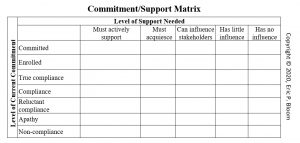If based on your business experience and understanding of future work activities, you have the ability to identify the specific people with whom you will be negotiating, you can set the stage to influence that negotiation well in advance of the actual negotiation process.
As an important note of caution, for these preparatory activities to be successful, you must ensure that those being influenced by these strategies cannot connect your influence-based activities to the future negotiation. If a connection is made, it can harm both your negotiating position and your professional brand.
Influencer #1: Personal connection
Begin to establish a trusted relationship with the opposing negotiators. It will be mutually beneficial for both sides for talking more honestly and openly. You don’t have to be friends, even though that would be nice, but you need to create a positive working relationship.
Think about it from your personal experience. You are more easily influenced by someone you trust, and conversely, it is easier to influence someone who trusts you. So, you are more likely to reach a negotiated agreement with someone you believe will hold up their end of the deal and will not try to take advantage of your goodwill.
Influencer #2: Use Observation to Understand a Person’s Interests
You can gain valuable insights into a person’s interests and persona by seeing their office space, either in-person or during a virtual meeting by analyzing the space behind them that is within camera shot. This is a technique often used by salespeople to:
- Find conversational topics.
- Find a common bond (common interest).
- Gain an understanding of the prospect’s:
- Values (pictures or awards from non-profit organizations)
- Priorities (pictures of family on their desk)
- Interests (world maps, sports memorabilia)
- Level of competitiveness (trophies or pictures of personal triumphs)
- Educational background (diplomas or memorabilia from their alma mater)
- Topics of literary interests (books on a bookshelf)
- Current literary interests (books on the desk)
Salespeople use this information to create a common bond with the prospect. This bond helps build trust, friendship, and hopefully, a very profitable, long-term relationship.
You can use this same technique to gain understanding of the people with whom you will be negotiating, requesting support from, or influencing in some way in the future.
Influencer #3: Reciprocity
Reciprocity means when you do something good for someone, they will feel a social obligation to do something good for you.
You can use this concept to your advantage by, as the opportunity presents itself, doing small, nice things for those with whom you will be negotiating. This small action will build goodwill toward you and instill a small feeling of obligation to return the favor.
Example tactics include:
- You receive an unsolicited email about a topic they may find interesting; forward it saying, “I saw this and thought of you.”
- Introduce a potential new client to a vendor.
- Tell the person’s manager about the great job the person is doing.
Influencer #4: Liking
People are more likely to be influenced by people they like. Therefore, if you get those future negotiation partners to like you, you will be better able to influence them during negotiation. Interestingly, the previously mentioned Reciprocity Influencer also has the benefit of getting people to like you just because you thought of them and did something nice.
Potential tactics include:
- Building your “Reciprocity Bank,” by doing small favors or unsolicited acts of kindness
- Finding common interests between you and the other person, through observation, as discussed in Influencer #1.
Influencer #5: Consistency/Currency Combination
Robert Cialdini’s principle of influence consistency and Cohen-Bradford’s concept of influence currencies create a very powerful combination. Consistency is the concept of getting someone to do a little of something now, so you can get them to do more of it later. The concept of influence currencies is finding something the other person is willing to receive in exchange for your influence. For example, if the person likes to be recognized for their hard work, influencing them a little now by recognizing their accomplishments and abilities, will condition them to be influenced later in greater ways using the same method.
As an added benefit, this type of influence currency also adds to liking.
This influencer can be employed using the following steps:
- Find the person’s influence currencies.
- Provide this currency in little doses over time.
- Get the person conditioned to receiving this currency.
- After the negotiation begins, provide currency in small doses during the negotiation in return for small negotiation favors.
These steps are designed to be similar to how casinos influence people to continue to play slot machines by providing ongoing small rewards.
Influencer #6: Inverted Influence
The Inverted Influence strategy is seemingly allowing yourself to be influenced by another person specifically to gain their attention, favor, trust, and support. Truth be told, I consider this influencer to be both manipulative and disingenuous, but it can be an effective strategy, nevertheless. Also, be very careful that others are not using this tactic on you. It works because it feels nice to believe you are able to influence others.
In closing from a negotiation perspective, gaining these types of favor in advance, makes it easier to influence others once you begin negotiating.





